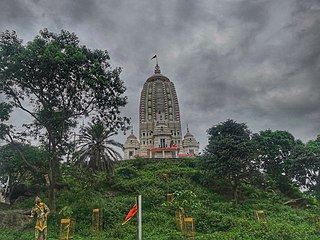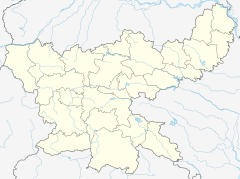
Veer Teja Ji, or Tejaji, is a Rajasthani folk deity. He is considered to be the eleventh incarnation of Shiva and worshipped as a deity in all of Rajasthan. Veer Teja was born around 29 January 1074, in Kharnal, Rajasthan, India. His parents, Ram Kunwari (mother) and Tahar Dev (father), were Jats. In India, Veer Tejaji, due to his sacrifice, is known as the God of Snakes.
Gumla is a city which is the district headquarters in the Gumla subdivision of the Gumla district in the state of Jharkhand, India.
Ramgarh Raj was the major Zamindari estate in the era of the British Raj in the former Indian province of Bihar. Territories which comprised the Ramgarh Raj presently constitute districts of Ramgarh, Hazaribagh, Chatra, Giridih, Koderma, and Bokaro with 3672 villages. The entire area is rich in minerals like coal and mica and falls under the Indian State of Jharkhand. The First King was Maharaja Baghdeo Singh and the last ruling king was Maharaja Kamakhya Narain Singh of this estate, until the estate was merged to the Republic of India. The revenue of the estate was about 3600000.

Nagpuri is an Indo-Aryan language spoken in the Indian states of Jharkhand, Chhattisgarh, Odisha and Bihar. It is primarily spoken in the west and central Chota Nagpur plateau region. It is sometimes considered a dialect of Bhojpuri.
The region have been inhabited since the Stone Age. Copper tools from the Chalcolithic period have been discovered. This area entered the Iron Age during the mid-2nd millennium BCE.
Tourism in Jharkhand refers to tourism in the Indian state of Jharkhand. Jharkhand is known for its waterfalls, hills and holy places.

The Nagvanshis of Chotanagpur, also known as the Khokhra chieftaincy, was an Indian dynasty which ruled the parts of Chota Nagpur plateau region during much of ancient, medieval and modern period. Phani Mukut Rai is considered the first king of dynasty claim to be son of Pundrika Naga, a mythical Naga. Lal Chintamani Sharan Nath Shahdeo (1931–2014) was last ruling king of the dynasty, until the estate was merged to the Republic of India.
The Nagpuria people, also Nagpuri or Sadan, are an Indo-Aryan speaking ethnolinguistic group who are the native speakers of the Nagpuri language and natives of the western Chota Nagpur Plateau region of Indian states of Jharkhand, Bihar, Chhattisgarh and Odisha.
Sadan are the native Indo-Aryan-speaking ethnolinguistic groups of Chota Nagpur Plateau consist of Indian state of Jharkhand and neighbouring states who speak Nagpuri, Khortha and Kurmali language as their native language.
Khukhragarh was one of the capitals of Nagvanshi dynasty, who once ruled in parts of the Indian state of Jharkhand. It is located in the Bero block in the Ranchi Sadar subdivision of Ranchi district.
Durjan Shah was a Nagvanshi king in the 17th century. He had built Navratangarh fort.

Navratangarh (Doisagarh) was one of the capitals of the Nagvanshi dynasty, who ruled parts of what is now the state of Jharkhand, India. It is located in Sisai block of Gumla district. It is said that king Durjan Shah shifted his capital from Khukhragarh to Navratangarh. He constructed the fort between 1636 and 1639. The palace was a five-storeyed structure with its "water-gate" and garh-khai (moat) arrangement. It has a kiaclmy (court), a treasury house and a prison-cell with its underground dungeon. It was declared national heritage in 2009.

Raghunath Shah was a Nagvanshi king in the 17th century. He succeeded his father Ram Shah in 1663. His capital was at Navratangarh. He built several temples during his reign.
Phani Mukut Rai was a legendary Nagvanshi king. According to the Nagvanshi tradition, he was first Nagvanshi king and founder of Nagvanshi dynasty in 1st century CE. However the story of Phani Mukut Rai is considered a myth by historians and scholars date the establishment of the Nagvanshi dynasty around 4th century CE.
Dalel Singh was the king of Karnpura during the 17th century. He shifted his capital from Badam in Barkagaon, which is now in Hazaribagh district, to Ramgarh in 1670 and family has used Ramgarh in official and other work after changing their capitals to other place.
Ram Shah was Nagvanshi king in 17th century. He succeed his brother Durjan Shah and ruled from 1640 to 1663 CE. Earlier their capital was at Khukhragarh, but later they shifted to Navratangarh. He was brother of king Durjan Shah.

Ani Nath Shahdeo was Nagvanshi king in 17th century. He was king of Barkagarh estate. He founded his capital at Satrangi near Subarnarekha river. He built Jagannath temple in 1691. He established Hat i.e. market at that place which is now known as Hatia.
The Barkagarh estate was a zamindari estate situated in modern-day Jharkhand, India, in erstwhile Lohardaga district. It was established by Ani Nath Shahdeo, the son of Nagvanshi king Ram Shah in 17th century. The capital of the estate was Satranji now located in south Ranchi.
Palkot is a village in the Palkot CD block in the Basia subdivision of the Gumla district in the Indian state of Jharkhand.
Gajghat Rai was Nagvanshi king in 9th century. He succeeded Gajdant Rai.






